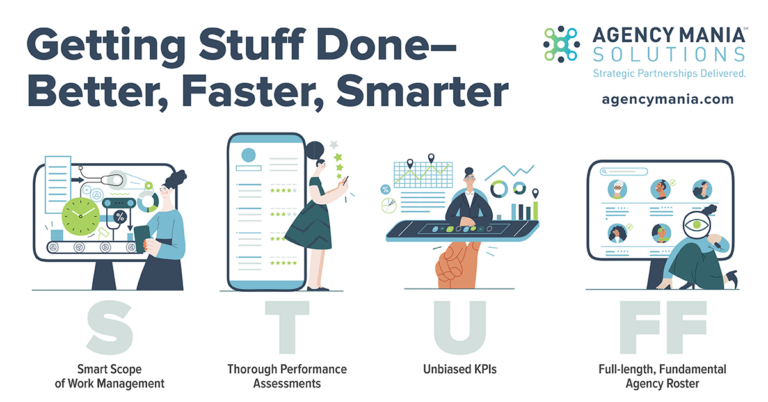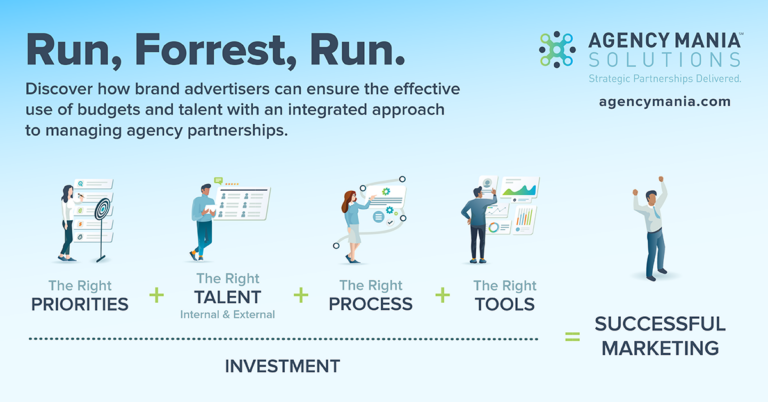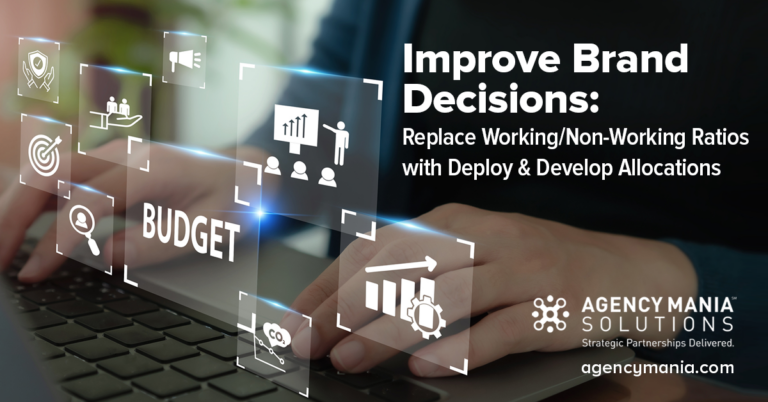Download a print-friendly version here
Industry data confirms a significant increase in roster changes and competitive reviews. Is the trend likely to continue in the years ahead? What are the implications for brand advertisers and their agencies?
A recent article by the Wall Street Journal quoted data from research firm Advertiser Perceptions that 58% of marketers plan to review their agencies in the next 12 months. The research was based on surveys of more than 300 marketers, representing 90% of Ad Age’s 100 Top Spenders.
Although the survey only asked about “intentions,” it’s fair to assume that a good number of respondents would go through with their plans and put one or multiple of their agencies in reviews. The Wall Street Journal article was written a few months ago. Let’s find out what actually happened in 2016.
2016 Year in Review:
- We saw a major increase in competitive agency reviews in 2016: The 4As accounted for over 400 reviews by the third quarter. Extrapolating these figures, we would look at approximately 570 accounts in reviews by year end, a 38% increase YOY. 58% of marketers plan to review their agencies in the next 12 months
- These reviews are taking place with major brands: At Agency Mania Solutions, we monitor the marketplace for such announcements and we accounted for a total of 156 major agency changes throughout 2016. We consider “major” agency changes those that took place among well-known, easily recognizable brands in the U.S. Narrowing down further, based on our data, 30 out of the top 100 leading U.S. advertisers changed agencies during that timeframe, selecting a new AOR for a particular discipline, brand or region. These top leading brands included (in alphabetical order): 21st Century Fox, Anheuser-Busch InBev, AT&T, Bayer, Coca-Cola Co., Diageo, Fiat Chrysler Automobile, General Mills, General Motors, GlaxoSmithKline, Hershey Co, JPMorgan Chase, Macy’s, Mattel, McDonald’s Corp, PepsiCo, Pfizer, Procter & Gamble Co (P&G), Reckitt Benckiser, Samsung Electronics, Sony, Sprint, Target, Time Warner, T-Mobile, Toyota Motor, Unilever, Viacom, Volkswagen Group and Walmart.
- The large majority of agency changes are the result of a formal competitive review: Out of the 156 major agency changes reported above, 116 or 74% of them were considered or formally announced as competitive reviews that involved multiples agencies. The remaining roster changes were handled without a review, often formalizing an AOR relationship with an agency that the brand had worked with previously. That was the case when Coca-Cola’s fairlife brand selected MDC Partners shop Doner as its creative and strategic agency of record, and when H&R Block hired independent Chemistry Communications as its new digital agency of record after years of collaboration.
- The incumbent agency had on average an 8.7-year relationship with the brand at the time of the review. Some of these relationships didn’t even last a full year. Are you surprised? Client/agency relationship longevity is on the decline, some suggesting three to four years on average. Many of these reviews, however, led to the demise of long-time relationships and were eye-opening. Reviews like McDonald’s received significant media coverage: the brand consolidated its agency business with Omnicom to bring its media and creative accounts under one roof (newly named “We Are Unlimited”), ending the 35-year U.S. relationship with Publicis’ Leo Burnett. Based on our data, we accounted for 10 major agency changes that had a decade-long or more relationship with their clients. Here is the list of 10+ year relationships that came to an end in 2016:
- Target and Haworth Marketing & Media – 46 years
- McDonald’s and Leo Burnett – 35 years
- Energizer Holdings and TBWA – 25 years
- Chick-fil-A and The Richards Group – 22 years
- US Bank and Empower MediaMarketing – 20 years
- Marks & Spencer and RKCR/Y&R – 16 years
- SAP and GMR – 16 years
- Time Warner and Ogilvy & Mather – 12 years
- Church & Dwight and Maxus – 10 years
- KFC and MEC – 10 years
- The reasons for these reviews range significantly. Some brands are establishing their first AOR relationship ever, like wearable tech company Fitbit, which awarded its media buying account to UM, and Uber, which selected Deutsch Los Angeles as its first U.S. creative lead agency. Most reviews are about addressing performance or capability concerns with the incumbent agency or consolidating work with fewer agencies. This is what Campbell Soup Co. did by consolidating its business from multiple shops to one with Anomaly. Same for Hulu, which recently consolidated its media planning and buying under IPG’s UM, replacing incumbent Razorfish for digital and Zenith for traditional media. Ikea consolidated its $444 million global media business into two holding companies, WPP and Dentsu Aegis Group, instead of relying on five holding companies. Hyatt Hotels Corp. selected MullenLowe as its global creative AOR for all 12 of its brands, work that was previously handled by eight or more agencies.
- The incumbent agencies often participated in the reviews but in some instances, they didn’t. That was the case for BBDO, which didn’t participate in the review by Hewlett Packard Enterprise due to its conflict with AT&T enterprise business. Pernod Ricard appointed Bartle Bogle Hegarty (BBH) London as lead creative global agency for Absolut Vodka, replacing four-year incumbent Sid Lee, which did not participate in the review either. Time Warner Cable hired DDB New York as its new agency, replacing 12-year incumbent Ogilvy & Mather, which did not participate in the review. Energizer Holdings selected Camp & King as its new global agency of record after a review, replacing incumbent TBWA, which handled the business for over 25 years but did not defend the account.
- The large majority of agency reviews were in the creative and media disciplines. The number of media reviews has been on the rise in the past few years. The 4As reported an 11% YOY increase in media (traditional and media) reviews in 2016. Based on our analysis of major brands, here were the major agency review categories of 2016: creative 50%, media 24%, integrated 12%, digital 8%, PR 4%, social and other 2%. Please note that digital, social and other more specialized marketing service categories (search, retail, sponsorships, etc.) might be under-represented here as those are less likely to receive media attention and be reported in the trade media.
- The use of search consultants is down YOY, suggesting that more brand advertisers are handling the review process on their own, assigning resources internally. One might easily conclude that advertisers are getting quite experienced in this area. The 4As reported that only 14% of account changes were handled by search consultants in 2016, a reduction of 3% YOY. Anecdotal data suggests that the largest reviews (in terms of total billings or those with a global scope), given their complexity, risks and scale, are typically handled by professional search consultants.
- Some reviews reflect the priorities of our time, including diversity. For example, General Mills required that participating agencies in its U.S. creative review were staffed with at least 50% women and 20% people of color within the creative department.
Beyond the tip of your iceberg
Now what? Significant time and efforts are often dedicated to conducting an agency review and selecting a new and hopefully long-term partner. However, the “a la Tinder” accelerated selection process of agencies by advertisers is only the tip of the iceberg when one contemplates the many responsibilities faced by clients wanting to turn these new partnerships into high-growth engines.
Onboarding new agency personnel quickly and efficiently
Post the review, the reality settles in and the priority is crystal clear: handling the transition from the incumbent agency to the new one, avoiding any disruption to the existing work. Efficiently onboarding new agency personnel, giving them access to training content, policies, guidelines and other critical information, allowing them to ramp up quickly.
Bringing to life a culture of feedback and mutual accountability
The new agency is now operationally sound and ready to handle work, and yet, how do we ensure the relationship will thrive and deliver on its promise? How do you avoid mistakes from the past and set up this new partnership for success? Being committed to an action-oriented client/agency performance evaluation feedback process ensures issues are raised early enough for adequate course correction.
Successful client/agency relationships thrive when client organizations enable great work and productive collaboration through efficient scope of work planning, quality briefing and effective decision making. The reality however is that too few advertisers yet commit to building a strong partnership platform on which these partnerships can flourish. Will you conduct an agency review this year? Maybe. But this may not be the right question to ask. Instead, ask yourself: Will I set up my agencies to succeed by enabling them to do their best possible work?
Download a print-friendly version here









